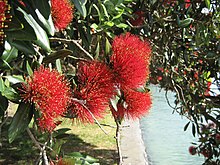Metrosideros excelsa
| Pōhutukawa | |
|---|---|

| |
| Pōhutukawa flowers | |
| Scientific classification | |
| Kingdom: | |
| Division: | |
| Class: | |
| Order: | |
| Family: | |
| Genus: | |
| Species: | M. excelsa
|
| Binomial name | |
| Metrosideros excelsa | |
| Synonyms | |
|
Metrosideros tomentosa | |
The Pōhutukawa (Metrosideros excelsa) is a coastal evergreen tree of the myrtle family that produces a brilliant display of red flowers made up of a mass of stamens. The Pōhutukawa is one of twelve Metrosideros species endemic to New Zealand.
Description
The tree grows to a height of up to twenty metres, with a dome-like spreading form. Its natural range is in the coastal regions of the North Island of New Zealand, from northern Taranaki on the west coast, and as far south as Gisborne on the east coast. It also grows on the shores of lakes in the Rotorua area. A giant Pōhutukawa in Te Araroa on the East Coast is reputed to be the largest in the country, with a height of 20 metres (65 ft) and a spread of 38 metres (125 ft).[1] Like its Hawaiian relative the ʻŌhiʻa lehua (M. polymorpha), the Pōhutukawa has shown itself to be efficient in the colonisation of lava fields, as on Rangitoto Island, a volcano in Auckland Harbour. The tree is also renowned as a cliff-dweller, due to its ability to maintain a hold in precarious, near-vertical situations. Some specimens have matted, fibrous aerial roots.
Flowers
Pōhutukawa flower from November to January with a peak in mid to late December (the southern hemisphere summer), with a brilliant crimson flower covering the canopy, hence their nickname 'the New Zealand Christmas Tree'. There is variation between individual trees both in the timing of flowering, and in the shade and brightness of the flowers. As well, genetic drift in isolated populations results in regional variation: for example, many of the trees growing around the Rotorua lakes produce pink-shaded flowers; and the yellow-flowered cultivar "Aurea" is descended from a pair discovered in 1940 on Mōtiti Island in the Bay of Plenty.
Conservation
In New Zealand, Pōhutukawa are under threat due to browsing by the common brushtail possum introduced from Australia, which strip the trees of their leaves. A charitable conservation trust, Project Crimson was formed with the aim of promoting the survival and reversing the decline in the numbers of Pōhutukawa and other Metrosideros species.
Cultivation

Fine examples of Pōhutukawa can be found in most North Island coastal cities. Vigorous and easy to grow, they are popular in cultivation, flourishing well south of their natural range in New Zealand; they have naturalised in the Wellington area and in the north of the South Island. Pōhutukawa have been introduced to other countries with mild-to-warm climates, including south-eastern Australia; as well, they have naturalised on Norfolk Island. In coastal California, they are a popular street and lawn tree. In parts of South Africa, the Pōhutukawa grows so well that it has become a nuisance, and is coming to be regarded as an invasive species.
See also
Notes
- ^ "Native Plant Information". Trees for Survival. Retrieved 2007.03.13.
{{cite web}}: Check date values in:|accessdate=(help)
References
- "Metrosideros excelsa". New Zealand Plant Conservation Network. Retrieved 2007-06-09.
- "Pohutukawa Fact Sheet" (PDF). Project Crimson. Retrieved 2007-06-09.
- Simpson, P., 2005. Pōhutukawa & Rātā: New Zealand's Iron-Hearted Trees. Wellington: Te Papa Press.
